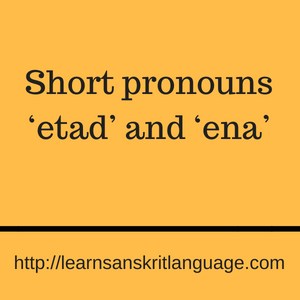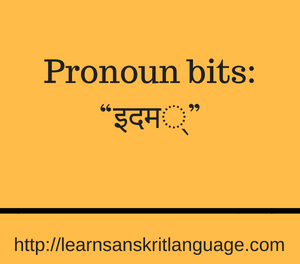We have studied earlier that there are three basic pronouns; मद्, त्वद्, and तद्. Out of these three, mad and tvad have optional short forms. They are normally used in poetry and not in sentences. So let’s take a look at them.
Short pronouns ‘etad’ and ‘ena’
mad (no gender)
| मद् | Singular | Dual | Plural |
|---|---|---|---|
| Case 1 (subject) | मा mā | नौ nau | नः naḥ |
| Case 2 (object ) | मे me | नौ nau | नः naḥ |
| Case 8 (address) | मे me | नौ nau | नः naḥ |
tvad (no gender)
| मद् | Singular | Dual | Plural |
|---|---|---|---|
| Case 1 (subject) | त्वा tvā | वाम् vām | वः vaḥ |
| Case 2 (object ) | ते te | वाम् vām | वः vaḥ |
| Case 8 (address) | ते te | वाम् vām | वः vaḥ |
etad
While tad refers to something far away, etad refers to something near to the speaker. This can be taken in a literal sense or abstract.
How to get etad from? It’s easy, just add –e vowel to the front of tad.
तस्मै → एतस्मै
tasmai → etasmai
For it (masculine or neuter)
तासाम् → एतासाम्
tāsām → etāsām
Of them (feminine)
स गच्छति → एष गच्छति
sa gacchati → eṣa gacchati
He goes.
Here the case 1 esah and esā have changed because of internal sandhi.
ena
ena is like a short form of tad, it is not capable of starting a sentence, it occurs in numbers and in a few cases. It refers to something that has already been mentioned. In order to use ena, replace the t part of tad with en. The examples are given below to help you out.
ena (masculine)
| एन | Singular | Dual | Plural |
|---|---|---|---|
| Case 2 (object) | एनम् enam | एनौ enau | एनान् enān |
| Case 3 (with ) | एनेन enena | - | - |
| Case 6 (of) | ते te | एनयोः enayoḥ | - |
| Case 7 (in) | - | एनयोः enayoḥ | - |




